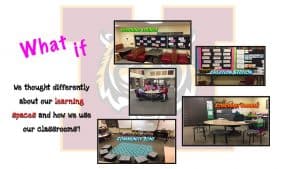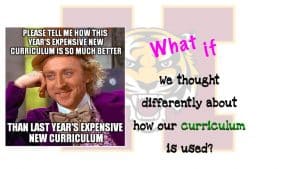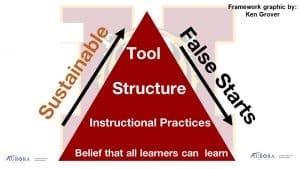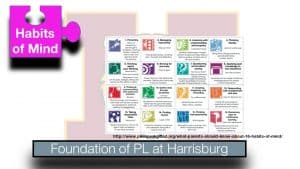Competency-Based Education in Harrisburg, South Dakota
CompetencyWorks Blog
T ravis Lape, Innovative Programs Director for the Harrisburg School District in South Dakota, was a presenter for the Introduction to Competency-Based Education breakout session at the Aurora Institute Symposium 2020. This blog post shares his remarks and selected slides.
ravis Lape, Innovative Programs Director for the Harrisburg School District in South Dakota, was a presenter for the Introduction to Competency-Based Education breakout session at the Aurora Institute Symposium 2020. This blog post shares his remarks and selected slides.
I’m so honored to be here and to share the amazing work that our staff has been doing. It’s deeply rooted in competency-based, personalized learning. Our district has been in this work for over ten years. We started at the high school level and then found out very quickly that we needed to bring it down to our middle and elementary schools. We’re the fastest growing district in our state—growing by 300 to 350 students per year—and that has allowed us some opportunities and flexibility with innovation.
Today I’m going to give you a high-level view of our elementary structure. We approach this by looking at what Dr. Tony Wagner says are the seven skills our children will need to survive in this changing world (see slide below).

And we have to ask ourselves if our schools are truly doing this. Are we being innovative and making sure that these seven skills are truly embedded into what we do every day with our kids—from our language, from the classes we teach, and the connections we make with our community? We come back to this all the time, asking ourselves: “When our students graduate from Harrisburg High School, will they be able to look at these seven skills and take hold of them?”
So we started asking some “What if?” questions. What if we thought about assessment differently? How could we start thinking about it differently? Rather than having it be paper-pencil assessment or fill-in-the-blank or multiple choice, what does this look like? What if we had our learners produce artifacts of knowledge and create a portfolio rather than one assessment at the end of a unit? What if we changed that, and what lends itself to that?
We asked the question, “What if we change our learning spaces?” Rather than having classrooms, we called them “learning studios,” and the reason for the learning studios is to be more like the real world. In the real world we have art studios and music studios. The artist goes into the studio, and all the tools are there for the artist to be successful. They have to put in their effort and their talent, but the sound board is there, the headphones and microphones are there. Same thing with our classrooms—the tools students need to be successful are inside our classrooms, but the learner has to take ownership. The learner has to drive that learning.
And so we have learning lounges in our studios, we have creation stations where they can create and think flexibly (see slide below). We have coaching corners where direct instruction can happen. We have the community zone where large groups can gather. And so again it’s back to thinking about our spaces and asking “What if we did this differently?” What if we created a learning studio and called it a learning a studio and created a language around that?

Then we dived into thinking about “What if we looked at our curriculum differently?” I think that the Willy Wonka and the Chocolate Factory meme here (see slide below) is fitting. “Please tell me how this year’s expensive curriculum is so much better than last year’s.” And we’ve all been there! You’ve been through an adoption of a new curriculum, and you’ve heard: “This curriculum is going to be the thing! This is the one that’s going to get us the results! This is going to fill the gaps that we’re missing!” And when we get into the actual work of it, we realize very quickly that the curriculum is a tool but it can’t entirely drive what we do.

So we have to ask ourselves, “What if we thought differently about curriculum?” In our personalization of the Harrisburg elementary schools, we asked the simple question, “What makes a second grader a third grader?” And when we ask teachers and parents that question, we get kind of this blank stare of “What do you mean?” And I say, “I honestly don’t know what makes your child a third grader after 180 days in school. Because maybe your child is still struggling with reading, but they’re doing math above grade level.” So why do we put them in these boxes?
When we think about what shifts we need to make in our environment, we’ve focused on four areas—flexible tools and spaces, data-driven instruction, learner agency, and targeted instruction. In our elementary schools we have no grade-level focus. We have cohorts of learners in 2nd through 5th grade, and we have 2nd-, 3rd-, 4th-, and 5th-grade teachers, but they no longer teach those grade levels. They teach learners. And we have learning continuums. We have the ability to move learners based on where they’re at and what they need, and it has really started to grow this idea of “we don’t need grade levels to educate children.” We need flexibility and we need the ability to empower our staff and our learners to drive their instruction.
We look at all of this through the lens of this triangle (see slide below). Too often we start from the top of the triangle, which is the direction of false starts. We try fixing something by purchasing a new tool. Maybe it’s a new curriculum, a new technology, or a new program. And then we figure out very quickly it doesn’t fit our school structure. Our structures don’t allow for it. Maybe I’m a teacher who has always taught whole-group, and now this new curriculum is telling me to teach small group? “That’s not going to work! I’m not going to use this!” Then we move down to instructional practices, and we look at Marzano or Hattie, and we find out that our tools and structures don’t even follow research findings about best practices. And then finally we get down to the belief that all learners can learn, and that’s why we all got into education—because we believe that all learners can learn.

So to make a sustainable, systematic change for the future, we have to start at the bottom of this triangle and ask ourselves “Do we truly believe that all learners can learn?” If we say yes to that, then nothing can stand in the way of making changes for our kids. But if we don’t answer that question honestly, and we just say “yes” at the surface level, that’s when we start to treat kids differently based on demographics or what side of town they come from. Then we miss the boat. And that is where we are right now in education. We have to believe that all learners can learn, no matter their background.
Continuing back up the triangle, we move back into instructional practices, structures, and tools. What are the instructional practices we’re going to use to push forward a shift in education? What structures do we need to change? And what tools are going to support that? If you go from the bottom up, I promise that you will make sustainable change happen in your district. Don’t go after a tool. Don’t go after a structure. Start at the belief that all learners can learn. Once our mindsets are made up there, and we’re believing that, we’re on the same train, that moves into the instructional practices.
For us, that starts with the Habits of Mind. These 16 habits by Bena Kallick and Art Costa (see slide below) are the foundation of what we’ve done. We learned about them from schools we visited in Maine. When you first look at the Habits of Mind, you say “Yeah, I talk about these. I talk about persisting or managing impulsivity or listening with understanding”—but do we really authentically teach it? Do we get our kids to use that language? And so we spend the first 15 days of school onboarding our learners with this idea of Habits of Mind. Thinking flexibly when things get difficult, applying past knowledge to different situations, questioning and problem-solving, remaining open to continuous learning. And it all starts with our language as educators. How are we embedding this in everything we do with our kids?

Then we move into looking at the puzzle pieces (see slide below). We have the Habits of Mind, and the rest of the puzzle pieces can’t come into play until we have that foundation. So next we looked at learning continuums. How do we know when kids are ready to move on? What can we use to move them on? So we had to get learning continuums put in place. Then we created flexible spaces with our staff and thought about what types of spaces would leverage this shift in our culture and our school.

And the final piece, the most important piece, is professional development. This work is not possible unless there’s a true investment in staff—for their time, for their commitment to this work, and truly making sure they feel supported to be able to implement the habits of mind, to build on the learner continuums and really understand where the learners are at, and how to empower them to use flexible spaces, so that it doesn’t become a management issue for them.
I gave you a very high level overview of what this is, because I was determined to give it my best shot in the ten minutes available! But please shoot me an email—I will set up a time to Zoom with your school or Zoom with your staff or whatever, and dive deeper into where and how we got this work started. It started ten years ago at our high school, and we now have it at the elementary and middle school levels too, so we have a progression that builds over time. Thank you!
Learn More